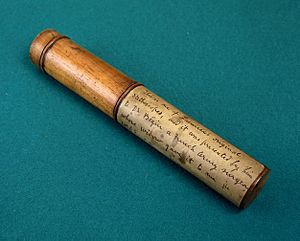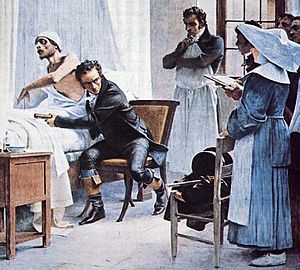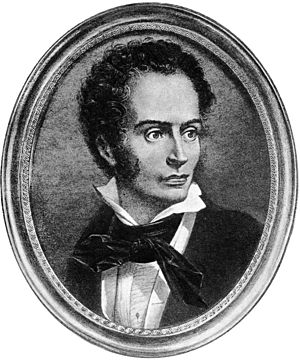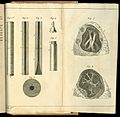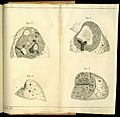René Laennec facts for kids
Quick facts for kids
René Laennec
|
|
|---|---|
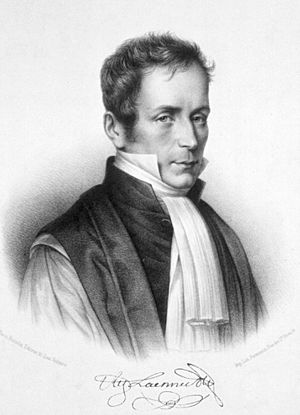 |
|
| Born |
René-Théophile-Hyacinthe Laennec
17 February 1781 |
| Died | 13 August 1826 (aged 45) Ploaré, France
|
| Alma mater | University of Paris |
| Known for | Inventing the stethoscope |
| Spouse(s) | Jacquette Guichard (1824-1826) |
René-Théophile-Hyacinthe Laennec (born February 17, 1781 – died August 13, 1826) was a French doctor and musician. He is famous for inventing the stethoscope in 1816. This amazing tool helps doctors listen to sounds inside the body. He created it while working at the Hôpital Necker in Paris.
Laennec was a pioneer in using the stethoscope to diagnose different chest problems. He became a lecturer and professor of medicine, sharing his knowledge with many students. Sadly, he died from tuberculosis at the age of 45.
Contents
Early Life and Education
René Laennec was born in Quimper, a town in Brittany, France. When he was only five years old, his mother passed away from tuberculosis. He then went to live with his great-uncle, a priest named Abbé Laennec.
As a child, René often felt tired and had fevers. He was also thought to have asthma. At age twelve, he moved to Nantes to live with another uncle, Guillaime-François Laennec, who worked at the university's medical school. René was a very talented student.
Even though his lawyer father wanted him to stop studying medicine, René returned to his studies in 1799. He studied medicine at the University of Paris. There, he learned from famous doctors like Jean-Nicolas Corvisart-Desmarets. These teachers taught him how to use sounds to help diagnose illnesses.
How the Stethoscope Was Invented
Before Laennec, doctors would place their ear directly on a patient's chest to listen to their heart and lungs. This method was often difficult, especially if the patient was overweight. It could also be uncomfortable or embarrassing, particularly when examining women.
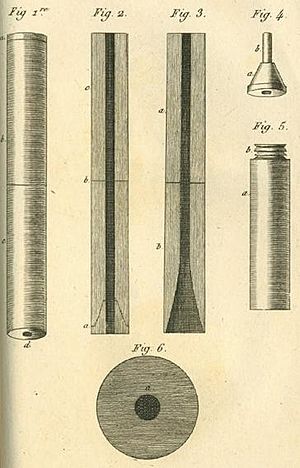
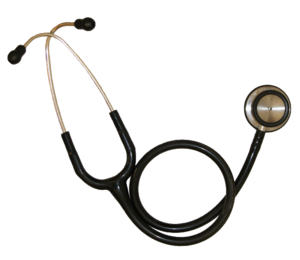
The idea for the stethoscope came to Laennec in a simple way. He saw children playing with long, hollow sticks. They would hold one end of the stick to their ear while scratching the other end. The stick made the sound louder and clearer. Laennec was also skilled at carving wooden flutes, which might have given him the idea for a hollow tube.
He created his first stethoscope from a hollow wooden cylinder, about 25 cm long and 2.5 cm wide. He later improved it into three parts. The new design had a funnel shape to make sounds even louder.
This invention changed medicine! Laennec could now listen to patients' chests more clearly. He could then compare these sounds with what he saw during autopsies (examinations after death). This helped him connect specific sounds to certain diseases. For example, he could better identify tuberculosis by listening to the sounds in the lungs.
Laennec was the first to name and describe sounds like rales (crackling), rhonchi (wheezing), crepitance (crackling or popping), and egophony (a bleating sound). Doctors still use these terms every day!
In 1819, Laennec published his important book, On Mediate Auscultation. He used the term mediate auscultation (meaning "indirect listening") to describe using his new tool. This was different from immediate auscultation, which was placing the ear directly on the chest. He named his instrument the stethoscope from Greek words: stethos (chest) and skopos (examination).
The stethoscope quickly became popular. Laennec's book was translated into many languages. However, not all doctors accepted it right away. Some preferred the old method. But over time, the stethoscope became an essential tool for doctors worldwide.
Laennec often called his invention "the cylinder." Before he died, he gave his own stethoscope to his nephew, calling it "the greatest legacy of my life."
The modern stethoscope, with two earpieces, was invented later in 1851 by A. Leared. In 1852, G.P. Cammann improved the design for mass production, creating the familiar stethoscope we see today.
Other Medical Discoveries
Laennec also helped us understand other diseases. He improved our knowledge of peritonitis (inflammation of the lining of the abdomen) and cirrhosis. He gave cirrhosis its name, using a Greek word that means "tawny" or "yellowish-brown." This color describes the damaged liver in people with the disease.
He also created the term melanoma for a type of skin cancer. He described how melanoma could spread to the lungs, a process called metastasis. In 1804, as a student, he gave the first lecture on melanoma.
Laennec also studied tuberculosis, the disease that caused his mother's death and eventually his own. He wrote a book called A Treatise on the Disease of the Chest. In it, he focused on chest diseases like tuberculosis and diagnostic methods like pectoriloquy (a way of listening to sounds from the chest).
Laennec believed in careful scientific observation. His work was so important that some medical experts compare it to the discoveries of other great medical figures like Vesalius and William Harvey.
Beliefs and Values
René Laennec was a very religious person and a devoted Catholic throughout his life. He was known for being a kind man and for his generosity to the poor. Many people said his charity was legendary.
Legacy and Tributes
Several medical terms are named after Laennec:
- Laennec's cirrhosis describes the appearance of a damaged liver.
- Laennec's thrombus refers to a blood clot in the heart before birth.
- Laennec's pearls are a type of sputum (mucus) produced by people with asthma.
- Hamman's murmur, also known as Laënnec–Hamman symptom, is a crunching sound heard in the chest due to air trapped in the chest cavity.
He has also been honored in other ways:
- One of the medical schools at the Claude Bernard University Lyon 1 in France is named after Laennec.
- On February 17, 2016, Google celebrated his 235th birthday with a special Google Doodle on their homepage.
Laennec in Stories and Films
A character named Rene Laennec appears in Rudyard Kipling's book Rewards and Fairies. In one story, set during the Napoleonic Wars, a young lady with tuberculosis talks about being treated by a French doctor who is a prisoner. This doctor, Rene Laennec, discusses using "wooden trumpets" to listen to patients' chests. This shows that Kipling knew about Laennec's work.
Laennec was also the subject of a 1949 French film called Doctor Laennec. The actor Pierre Blanchar played him in the movie.
Laennec's Landmarks in Paris
At the Hôpital Necker – Enfants Malades in Paris, where Laennec wrote his famous book, there is a special memorial. On the hospital's outer wall, near the entrance, you can find a marble tablet. It has an engraved picture of Laennec and an inscription that says: "In this hospital Laennec discovered auscultation. 1781–1826." Some of the hospital's oldest buildings can still be seen there today.
-
Drawings of diseased lungs from Laennec's book. These images show lungs affected by tuberculosis.
See Also
 In Spanish: René Laënnec para niños
In Spanish: René Laënnec para niños


